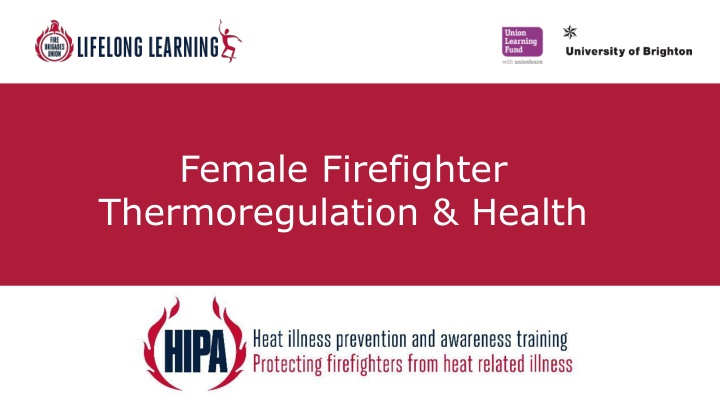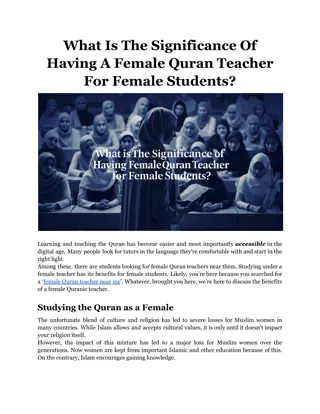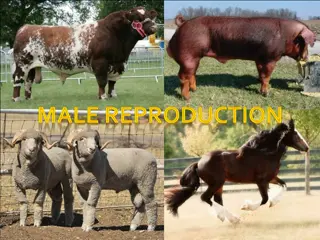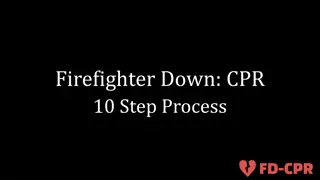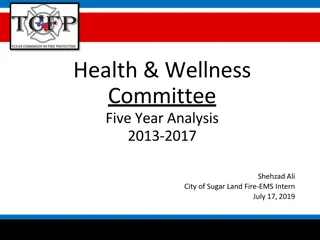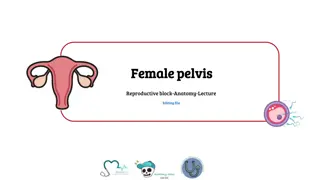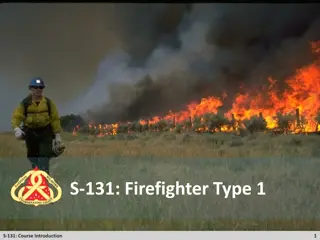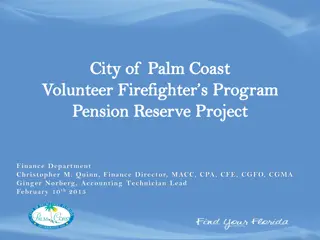Female Firefighter Thermoregulation & Health Insights
For female firefighters, thermoregulation is vital for maintaining core temperature while facing environmental challenges. Research shows females have lower heat tolerance and may require higher core temperatures to trigger sweating. Issues such as obesity, high blood pressure, strength levels, and alcohol use differ between genders. Female firefighters also face concerns related to menopause impact on work life and long-term job demands. Health risks and musculoskeletal injuries are notably higher in this occupation, highlighting the need for gender-specific health research and support.
Download Presentation

Please find below an Image/Link to download the presentation.
The content on the website is provided AS IS for your information and personal use only. It may not be sold, licensed, or shared on other websites without obtaining consent from the author.If you encounter any issues during the download, it is possible that the publisher has removed the file from their server.
You are allowed to download the files provided on this website for personal or commercial use, subject to the condition that they are used lawfully. All files are the property of their respective owners.
The content on the website is provided AS IS for your information and personal use only. It may not be sold, licensed, or shared on other websites without obtaining consent from the author.
E N D
Presentation Transcript
Female Firefighter Thermoregulation & Health
Background A set core temperature is normally maintained by the body Thermoregulation is challenged by environmental extremes Sweating is limited when wearing protective clothing Research indicates females are less tolerant to hot environments than males A higher core temperature is needed to stimulate sweating in females Heat tolerance may also be altered by hormone release in females
Background Jahnke et al. 2012 (USA) Obesity: 16.7% of females vs 33.5% of males High blood pressure: 16.7% vs 53.9% Average to High Strength: 94.1% vs 84.6% Haddock et al. 2017 (USA) Alcoholic Binge Drinking: 39.5% female vs 50% male Problem drinkers 2.5 times more likely to have PTSD Gendron et al. 2018 (Canada) 76% at moderate to high CVD risk 82% not meeting fitness requirements Jahnke et al. 2018 (USA) 10-15% don t restrict duties when pregnant 73.9% running fire calls 23 - 33% miscarry 12-17% of births pre-term (<37 weeks) Majority of health & exposure research has Majority of health & exposure research has been conducted on male firefighters been conducted on male firefighters
Are sex differences important? 1.4 L.hr-1 vs 0.6 L.hr-1 FSI CON 37.2 37.4 37.6 37.8 38.0 38.2 38.4 38.6 38.8 39.0 39.2 Rectal Temperature ( C) Continuum
Health UK&I NA AUS EU 40% NA 2-7 times more likely to experience health issues caused by the occupation Percentage of Participants (%) 35% 30% 25% 20% 15% 10% UK & I 10-20% experience musculoskeletal injuries or depression/PTSD 5% 0% Health Issues
Health Is the menopause something you are worried about in relation to your working environment and/or tasks? 17% are peri/menopausal Lack of Knowledge Change in strength & fitness Fatigue Dizzy Spells Changes in temperature Concern for mental health Mood Swings regulation Strength Loss 39% it impacts working life Embarrassment in male Hot flushes environment 36% worried about the menopause If you are currently experiencing the menopause, does this have any impact on your working life?
Health Only 16% were confident they would be able to meet the demands of their job at 60 yrs of age I don't know if I will be able to achieve 60 but I will give it a good try! I do feel let down by changes to the pension and retirement age and don't feel that females have been taken into account especially when I would imagine every female hitting menopause before this age! Meeting fitness standards Loss of Strength Mental toughness I haven't received any information or guidance on the effect of being an older lady & the menopause whilst being an operational firefighter Impact of the menopause Injuries/pain
Menstrual cycle effects on thermoregulation > Phases and hormones The cycle lasts approximately 28 days and is made up of different phases with varying hormone levels Oestrogen peaks before ovulation Progesterone levels are low in the follicular phase Oestrogen reduces body temperature Progesterone increases vasoconstriction
Menstrual cycle effects on thermoregulation > Phases and hormones Follicular Luteal 39.2 Core Temperature ( C) 38.8 38.4 38.0 37.6 37.2 36.8 rest 0 5 10 15 20 25 30 35 40 Time (minutes)
Menstrual cycle effects on thermoregulation > Thermoregulation changes Changing hormone levels affect thermoregulation throughout the cycle Exercising in the heat delays the onset of sweating There is a higher sweat rate in the follicular phase of the cycle During the luteal phase it is possible to have a higher subjective feeling of exhaustion
Menstrual cycle effects on thermoregulation > Fitness helps During the luteal phase compared to the follicular phase, females fatigue quicker. No differences in trained individuals No difference in core temperature in trained individuals during the cycle Evidence is conflicting as to whether thermoregulatory difference in menstrual cycle phases have an impact on exercising in the heat.
Contraceptives and thermoregulation > Types Contraceptives prevent ovulation from occurring Oral contraceptives lower core temperature Long term use can lead to higher core temperature when exercising However it was also found that there was no difference in skin temperature between users and non-users
Contraceptives and thermoregulation > Types No difference was found in core temperature following exercise between users and non-users of oral contraceptives
Menopause effects on thermoregulation > What is the menopause? Menopause occurs around the age of 51 It is when the ovaries stop producing reproductive cells
Menopause effects on thermoregulation > What does the menopause affect? Perimenopause leads to variation in oestrogen levels Approximately 80% of women experience hot flushes and night sweats through menopause Varying oestrogen levels can effect females through sleep disturbance, somatically, and psychologically
Menopause effects on thermoregulation > Thermo-neutral zone Increases in core temperature result in heat dissipation due to acting outside the thermoneutral zone In symptomatic women temperature limit narrows lowering the sweating threshold resulting in hot flushes until the core temperature returns to the thermoneutral zone
Menopause effects on thermoregulation > Core temperature 39.5 Menopausal Regular Cycles Neither group is specifically worse in terms of heat tolerance 39.0 Core Temperature ( C) 38.5 38.0 37.5 38.38 0.3 C vs 38.72 0.54 C 37.0 36.5 Rest 0 5 10 15 20 25 30 35 40 Time (minutes)
Bone, muscle and fitness with ageing > Bone mineral density There is a correlation between aging and decreasing bone mass Declining bone mass leads to increased risk of fractures Decreasing oestrogen levels leads to greater bone mass loss in women Weight bearing and resistance exercise is beneficial for treatment and prevention of osteoporosis
Bone, muscle and fitness with ageing > Cardiorespiratory fitness As age increases, maximal oxygen uptake declines There is some evidence that higher cardiorespiratory fitness levels reduce the risk of bone loss post-menopause There are changes in cardiopulmonary function associated with menopause Regular exercise can aid to reduce the rate of bone loss Post menopause there is a lowered cardiorespiratory fitness level
Bone, muscle and fitness with ageing > Muscle mass & strength Menopause can contribute to declining muscle mass After the age of 50 there is a pronounced decline in muscle strength Contradicting research exists as to whether this decline is linked to lowered oestrogen levels
Bone, muscle and fitness with ageing > Muscle mass & strength Sufficient vitamin D intake is essential for bone health Much of the decline in muscle strength can be attributed to reduced physical activity and hormonal changes For women over 50, the recommended daily intake of calcium is 1200mg Female firefighters should be encouraged to maintain fitness levels and strength based activities Postmenopausal women can improve bone mineral density with appropriate nutrition
Fertility and Maternal Health All UK Fire and Rescue services have individual policies for pregnancy Certain aspects of firefighting increase the risk of miscarriage Fertility is possibly altered
Key Points Little data is available as to how women react to severe heat stress Women have an altered later sweat response and therefore reduced heat tolerance compared to men Heat loss is aided by a higher sweat rate in the early follicular phase of the menstrual cycle During peri-menopause hot flushes are caused by sudden small increases in core temperature Post menopause there is a low resting core temperature, suggesting improved heat tolerance than pre-menopause www.fbueducation.org
References Abdulnour, J. (2016) The Effect of Menopausal Transition on Body Composition, Cardiometabolic Risk Factors, Physical Activity and Cardiorespiratory Fitness, unpublished thesis Universit d'Ottawa/University of Ottawa. Bachmann, G. A. (2005) "Menopausal vasomotor symptoms: a review of causes, effects and evidence-based treatment options", The Journal of reproductive medicine, 50 (3) pp. 155-165. Betik, A. C. and Hepple, R. T. (2008) "Determinants of VO2 max decline with aging: an integrated perspective", Applied Physiology, Nutrition, and Metabolism, 33 (1) pp. 130-140. Boni, R. (2019) "Heat stress, a serious threat to reproductive function in animals and humans: BONI", Molecular Reproduction and Development. Casa, D. J., DeMartini, J. K., Bergeron, M. F., Csillan, D., Eichner, E. R., Lopez, R. M., Ferrara, M. S., Miller, K. C., O'Connor, F. and Sawka, M. N. (2015) "National Athletic Trainers' Association position statement: exertional heat illnesses", Journal of athletic training, 50 (9) pp. 986-1000. Charkoudian, N. (2003) Skin blood flow in adult human thermoregulation: how it works, when it does not, and why, translated in Elsevier, 603-612. Cheung, S. S., McLellan, T. M. and Tenaglia, S. (2000) "The thermophysiology of uncompensable heat stress", Sports Medicine, 29 (5) pp. 329-359. Cheuvront, S. N., Kenefick, R. W., Montain, S. J. and Sawka, M. N. (2010) "Mechanisms of aerobic performance impairment with heat stress and dehydration", Journal of Applied Physiology, 109 (6) pp. 1989-1995. da Rocha Arag o, F. (2015) Exercise, Body Composition, Cardiorespiratory Fitness and Menopausal Characteristics: Effects and Interactions, unpublished thesis Universidade de Tras-os-Montes e Alto Douro (Portugal).
References Deecher, D. and Dorries, K. (2007) "Understanding the pathophysiology of vasomotor symptoms (hot flushes and night sweats) that occur in perimenopause, menopause, and postmenopause life stages", Archives of women's mental health, 10 (6) pp. 247-257. DeFina, L. F., Leonard, D., Willis, B. L., Barlow, C. E., Finley, C. E., Jenkins, M. R., Pence, B. C., Zhang, Y., Chyu, M.-C., Lewiecki, E. M. and Shen, C.-L. (2016) "High Cardiorespiratory Fitness Is Associated with Reduced Risk of Low Bone Density in Postmenopausal Women", Journal of Women's Health, 25 (10) pp. 1073-1080. Doherty, T. J. (2001) "The influence of aging and sex on skeletal muscle mass and strength", Current Opinion in Clinical Nutrition & Metabolic Care, 4 (6) pp. 503-508. Eglin, C. M. (2007) "Physiological responses to fire-fighting: Thermal and metabolic considerations", Journal of the human- environment System, 10 (1) pp. 7-18. Feodor Nilsson, S., Andersen, P. K., Strandberg Larsen, K. and Nybo Andersen, A. M. (2014) "Risk factors for miscarriage from a prevention perspective: a nationwide follow up study", BJOG: An International Journal of Obstetrics & Gynaecology, 121 (11) pp. 1375-1385. Freedman, R., Norton, D., Woodward, S. and Corn lissen, G. (1995) "Core body temperature and circadian rhythm of hot flashes in menopausal women", The Journal of Clinical Endocrinology & Metabolism, 80 (8) pp. 2354-2358. Freedman, R. R. (2014) "Menopausal hot flashes: mechanisms, endocrinology, treatment", The Journal of steroid biochemistry and molecular biology, 142 pp. 115-120. Freedman, R. R. and Blacker, C. M. (2002) "Estrogen raises the sweating threshold in postmenopausal women with hot flashes", Fertility and sterility, 77 (3) pp. 487-490.
References Haskell, W. L., Lee, I. M., Pate, R. R., Powell, K. E., Blair, S. N., Franklin, B. A., MacEra, C. A., Heath, G. W., Thompson, P. D. and Bauman, A. (2007) "Physical activity and public health: Updated recommendation for adults from the American College of Sports Medicine and the American Heart Association", Medicine and Science in Sports and Exercise, 39 (8) pp. 1423-1434. Jahnke, S. A., Poston, W. S. C., Jitnarin, N. and Haddock, C. K. (2018) "Maternal and Child Health Among Female Firefighters in the U.S", Maternal and Child Health Journal, 22 (6) pp. 922-931. Janse, X. D. J., Thompson, M. W., Chuter, V. H., Silk, L. N. and Thom, J. M. (2012) "Exercise performance over the menstrual cycle in temperate and hot, humid conditions", Medicine and science in sports and exercise, 44 (11) pp. 2190-2198. Kolka, M. A. and Stephenson, L. A. (1989) "Control of sweating during the human menstrual cycle", European journal of applied physiology and occupational physiology, 58 (8) pp. 890-895. Kuwahara, T., Inoue, Y., Abe, M., Sato, Y. and Kondo, N. (2005) "Effects of menstrual cycle and physical training on heat loss responses during dynamic exercise at moderate intensity in a temperate environment", American Journal of Physiology - Regulatory Integrative and Comparative Physiology, 288 (5) pp. R1347-R1353. Lee, H., Petrofsky, J., Shah, N., Awali, A., Shah, K., Alotaibi, M. and Yim, J. (2014) "Higher sweating rate and skin blood flow during the luteal phase of the menstrual cycle", The Tohoku journal of experimental medicine, 234 (2) pp. 117-122. Lei, T.-H., Stannard, S. R., Perry, B. G., Schlader, Z. J., Cotter, J. D. and M ndel, T. (2017) "Influence of menstrual phase and arid vs . humid heat stress on autonomic and behavioural thermoregulation during exercise in trained but unacclimated women: Thermoregulatory behaviour in trained women across the menstrual cycle", The Journal of Physiology, 595 (9) pp. 2823-2837. Marsh, S. A. and Jenkins, D. G. (2002) "Physiological responses to the menstrual cycle", Sports Medicine, 32 (10) pp. 601-614. Minahan, C., Melnikoff, M., Quinn, K. and Larsen, B. (2017) "Response of women using oral contraception to exercise in the heat", European journal of applied physiology, 117 (7) pp. 1383-1391.
References National Institutes of Supplements, O. o. D. (2019) 'Calcium', [online], National Institutes of Health. Available: <https://ods-od-nih-gov.ezproxy.brighton.ac.uk/factsheets/calcium-HealthProfessional/> [Accessed 15th July 2019]. Notley, S. R., Dervis, S., Poirier, M. P. and Kenny, G. P. (2018) "Menstrual cycle phase does not modulate whole body heat loss during exercise in hot, dry conditions", Journal of Applied Physiology, 126 (2) pp. 286-293. Notley, S. R., Dervis, S., Poirier, M. P. and Kenny, G. P. (2019) "Menstrual cycle phase does not modulate whole body heat loss during exercise in hot, dry conditions", Journal of applied physiology (Bethesda, Md. : 1985), 126 (2) pp. 286-293. Rolland, Y. M., Perry Iii, H. M., Patrick, P., Banks, W. A. and Morley, J. E. (2007) "Loss of appendicular muscle mass and loss of muscle strength in young postmenopausal women", The Journals of Gerontology Series A: Biological Sciences and Medical Sciences, 62 (3) pp. 330-335. Roush, K. (2011) "Prevention and Treatment of Osteoporosis in Postmenopausal Women: a review", The American Journal of Nursing, 111 (8) pp. 26-37. Shaver, J. L. and Paulsen, V. M. (1993) "Sleep, psychological distress, and somatic symptoms in perimenopausal women", Family practice research journal. Sims, S. T. and Heather, A. K. (2018) "Myths and Methodologies: Reducing scientific design ambiguity in studies comparing sexes and/or menstrual cycle phases", Experimental physiology, 103 (10) pp. 1309-1317. Sturdee, D., Wilson, K., Pipili, E. and Crocker, A. D. (1978) "Physiological aspects of menopausal hot flush", Br Med J, 2 (6130) pp. 79-80. Tenaglia, S. A., McLellan, T. M. and Klentrou, P. P. (1999) "Influence of menstrual cycle and oral contraceptives on tolerance to uncompensable heat stress", European journal of applied physiology and occupational physiology, 80 (2) pp. 76-83. Watkins, E. R., Walker, A., Mol, E., Jahnke, S. and Richardson, A. J. (2019) "Women Firefighters Health and Well-Being: An International Survey", Women's Health Issues.
